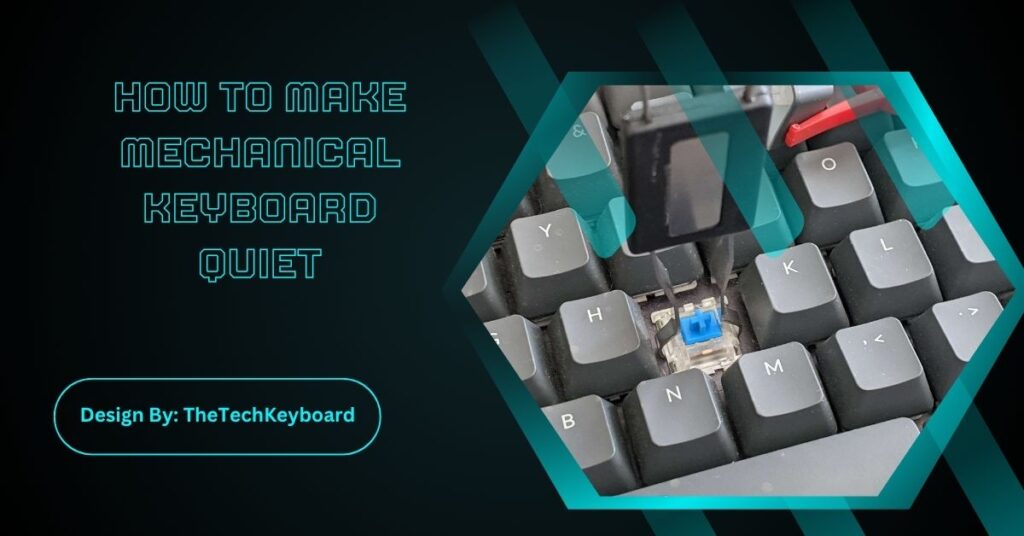To make a mechanical keyboard quiet, use silent switches, O rings, foam dampening, lubing, and desk mats. These modifications reduce noise while maintaining the typing feel and performance for work or gaming.
Mechanical keyboards are loved for their tactile feedback and durability, but their loud clicking sound isn’t always welcome especially in shared offices, libraries, or during late-night gaming. Fortunately, there are many ways to dampen keyboard noise without losing the satisfying feel of mechanical switches.
In this guide, we’ll cover how to reduce mechanical keyboard noise, the best ways to silence a mechanical keyboard, and the modifications you can make for a truly quiet mechanical keyboard.
Why Mechanical Keyboards Can Be Loud?
The sound from a mechanical keyboard comes from multiple factors:
- Switch Type: Some switches, like blue clicky switches, produce more noise than silent mechanical keyboard switches such as Cherry MX Silent or Gateron Silent.
- Keycap Material: Thin ABS keycaps tend to amplify sound, while quiet mechanical keycaps like PBT absorb vibrations better.
- Case Design: Hollow cases without padding allow sound to echo.
- Typing Force: Pressing keys too hard increases bottom-out noise.
Understanding these factors is the first step in choosing the right keyboard sound dampening mods.
Switch to Silent Mechanical Keyboard Switches

One of the most effective methods for mechanical keyboard noise reduction is replacing your switches with noise-reducing mechanical switches.
Quietest Mechanical Keyboard Switches
- Cherry MX Silent Red / Silent Black: Linear feel with built-in dampening.
- Gateron Silent Red / Silent Brown: Smooth travel with reduced actuation noise.
- Kailh Silent Box: Sealed design to prevent sharp clicks.
If your keyboard has hot-swappable switches, you can easily replace noisy switches without soldering, making this a great keyboard modding for sound control option.
Install O-Rings or Switch Dampeners
Do O-rings make mechanical keyboards quieter? Yes! These mechanical keyboard o-rings fit under the keycaps to absorb the impact when you bottom out a key.
- Pros: Affordable, easy to install, effective at reducing bottom-out noise.
- Cons: Slightly changes key feel, may shorten travel distance.
If you’re looking for the cheapest way to quiet mechanical keyboard, O-rings are an excellent starting point.
Lube Your Switches
Lubing mechanical keyboard switches reduces friction and rattling, leading to smoother and quieter keystrokes.
Steps:
- Remove keycaps and switches.
- Open each switch using a switch opener.
- Apply thin layers of keyboard lubricant to the stem, spring, and housing.
Tip: Pair lubing with foam dampening inside keyboard case for maximum effect.
Add Foam or Dampening Material Inside the Case
A hollow keyboard case can amplify sound like a drum. Placing foam inside helps absorb vibrations.
- Popular Materials: EVA foam, shelf liner, neoprene.
- Benefits: Reduces echo, improves typing feel, creates a more solid sound profile.
- Extra Tip: This works well for gasket mounted keyboards for quiet typing.
Use a Desk Mat or Soundproof Keyboard Setup
Placing a desk mat for keyboard noise reduction under your keyboard can significantly cut vibrations traveling to your desk.
- Choose thick, soft materials for better sound absorption.
- Improves both aesthetics and comfort during typing.
This is a simple how to soundproof a keyboard for an office trick that works instantly.
Change Keycaps to Quieter Materials
Thin keycaps make keyboards louder. Switching to PBT keycaps for noise absorption can reduce high-pitched clicks and create a more muted sound.
Keycap Tips:
- PBT > ABS for sound dampening.
- Thicker walls provide deeper sound.
- Doubleshot PBT retains legends longer without extra noise.
Adjust Your Typing Technique
Not all noise comes from the keyboard itself—your typing style matters too.
- Avoid bottoming out keys.
- Type with a lighter touch.
- Keep wrists elevated for better control.
Sometimes, the best way to silence a mechanical keyboard is simply to adapt your typing.
Consider Linear vs Tactile Quiet Switches
For ultimate quietness, linear switches are generally quieter than tactile ones. If you still want some feedback, opt for tactile silent switches.
| Switch Type | Noise Level | Best For |
| Clicky (e.g., MX Blue) | Loud | Typing feel, not for quiet use |
| Tactile (e.g., MX Brown Silent) | Medium Quiet | Balanced typing experience |
| Linear (e.g., MX Silent Red) | Very Quiet | Gaming, office work |
Combine Multiple Noise Reduction Mods
For maximum effect, combine several techniques:
- Silent mechanical keyboard switches
- O-rings
- Foam dampening
- Lubed switches
- Desk mat setup
This layered approach creates an almost soundproof keyboard setup.
Office Friendly Mechanical Keyboard Setups

If you work in a quiet office, opt for:
- Silent switches (Cherry MX Silent, Gateron Silent)
- Foam-filled case
- PBT keycaps
- Desk mat
This ensures your typing won’t disturb coworkers while keeping the mechanical feel.
Quick Tips for Making Mechanical Keyboards Quieter
- Use quiet mechanical keycaps and thick PBT material.
- Choose noise-reducing mechanical switches over clicky ones.
- Try a desk mat for keyboard noise reduction.
- Use mechanical keyboard o-rings for affordable noise control.
- Avoid unnecessary force when typing.
FAQs:
1. What are the quietest mechanical keyboard switches?
Cherry MX Silent Red, Gateron Silent Red, and Kailh Silent Box are among the quietest switches. They feature built-in dampening to reduce actuation noise while preserving smooth keystrokes, making them ideal for office or home use.
2. Do O-rings really help reduce keyboard noise?
Yes. O-rings absorb the impact when keys bottom out, significantly lowering the sound. They’re inexpensive, easy to install, and perfect for those looking for the cheapest way to quiet a mechanical keyboard without complex mods.
3. How can I make my keyboard quieter without replacing switches?
Use mechanical keyboard O-rings, add foam dampening inside the case, switch to PBT keycaps, place a desk mat underneath, and lube your existing switches. These methods can noticeably reduce noise without changing the switch type.
4. Is it possible to have a quiet mechanical keyboard for the office?
Yes. Choose silent switches, PBT keycaps, and add foam dampening. Combine these with a thick desk mat to prevent vibrations. This setup keeps noise low, making it perfect for professional environments without losing mechanical feel.
5. What’s the best way to fully soundproof a keyboard?
Combine multiple mods: silent mechanical switches, O-rings, case foam, lubed switches, and a desk mat. This layered approach greatly reduces noise and creates an office-friendly, nearly soundproof typing experience without losing responsiveness or comfort.
Conclusion:
A noisy mechanical keyboard can be transformed into a quiet, office-friendly tool with the right modifications. Switching to silent mechanical switches, adding O-rings, lubing switches, using foam dampening, and placing a desk mat can all significantly reduce sound. Whether you’re working in an office, studying in a library, or gaming late at night, these noise-reduction methods maintain the mechanical feel you love while keeping noise levels low. By combining multiple solutions, you can enjoy a comfortable, quiet, and highly functional typing experience anywhere.


